Top-of-the-line cars used to almost always be sedans, but that layout has fallen out of favor because of the modern sedan’s comparatively small trunk – and limited versatility. Even long-time big-sellers in the family car segment like the Toyota Camry and Honda Accord sedans are struggling – arguably for the same reason.
Which is probably why VW decided to make its new top-of-the-line Arteon sedan a hatchback.
Whoops!
VW calls it a “Gran Turismo” with “coupe-like styling,” because that connotes better. But the function – and purpose – are the same.
Well, more.
Compared with the almost identically sized Passat sedan – which has a trunk – the Arteon has three times as much space for stuff.
It also has much more power – as well as some things you never used to be able to get in a VW, like a massaging driver’s chair.
Not even the $70k Phaeton had that.
And this new Arteon costs tens of thousands less than that.
The Arteon is VW’s new “halo” car – industry-speak for a top-of-the-line model. It’s VW’s first post-Phaeton (and Comfort Coupe – which was also a sedan) attempt at a high-end model . . . this time with a price more in line with VW models, VW buyers’ budgets – and sensibilities.
It’s about the same size as the Passat sedan, so mid-sized edging toward full-size – but comes standard with one of VW’s most powerful engines and offers AWD, which is no longer available in the current Passat.
It also offers luxury car stuff – like the massaging driver’s seat mentioned earlier – that you generally have to spend luxury brand bucks to enjoy.
Prices start at $35,845 for the SE trim with turbocharged 268 hp engine and front-wheel-drive.
A top-of-the-line SEL Premium R-Line with brushed metal interior trim, AWD, the Oh Behave! massaging driver’s seat, heated rear seats (plural, baby, yeah) a full-length panorama sunroof and a 700 watt, 13 speaker Dynaudio stereo with 13 speakers stickers for $46,710.
What’s New
The Arteon is all-new, as is its position at the top of VW’s lineup.
The Passat – which was VW’s largest/most luxurious sedan – is now VW’s value-priced large sedan.
Sleeker – and more practical – than the Passat.
Second row as roomy as first, both leg and headroom-wise.
Minor price bump to get AWD in SE and SEL trims.
What’s Not So Good
Massaging seat (only the driver gets a back rub) is limited to the SEL trim, which starts at $44,945.
Slinky stance – just 5.4 inches off the pavement – cancels out much of the winter-weather advantages of AWD.
Center console storage cubby is tiny and awkward placed.
All trims come standard with a 2.0 liter four cylinder engine paired with an eight-speed automatic transmission and your pick of FWD or AWD.
The engine makes 268 hp and 258 ft.-lbs. of torque at just 1,950 RPM – courtesy of almost 31 lbs. of boost (more below).
For cross-shop purposes, the current Passat’s version of the 2.0 liter engine only manages 174 hp.
Not surprisingly, the Arteon is much quicker than the pokey Passat. Zero to 60 takes about 6 seconds vs. more than eight for its less muscular same-sized brother.
The bad news – if you care about such things – is that the Arteon uses noticeably more gas: 20 city, 27 highway vs. 25 city, 36 highway for the less powerful but more parsimonious Passat.
Some very good news: The Arteon’s engine is direct-injected but has a separate port-fuel-injection circuit – there to to nip any potential carbo-fouling problems from the DI system (which is there for fatwa-compliance reasons) in the bud.
The Arteon’s engine is pressurized to an almost Indy Car 31 psi under full throttle. That’s what it takes, apparently, to get the power of a six out of a four. Put more precisely, to maintain the power of a six while getting rid of sixes.
VW – the entire car industry – is facing crunch time. How to maintain the power/performance that buyers expect – while also complying with the strong-arming fatwas of government?
Note that VW no longer offers its 3.6 liter V6 (which made 280 hp) in any of its new passenger cars – including the Arteon or the Passat.
It’s been mothballed – permanently.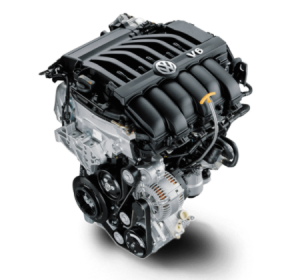
The reasons for that having to do not with lack of buyer interest in sixes – or horsepower – but rather with federal fuel economy fatwas, which have sleazily morphed into “emissions” fatwas. The IC engine is getting smaller – with the aim being to make it disappear altogether.
In favor of the electric motor. Which is allegedly “cleaner” than an IC engine because it creates no carbon dioxide – locally. At the power plant (and open pit mine) is another matter.
Never mind.
It’s possible to make an IC engine run so cleanly it produces almost no harmful emissions. More than possible. It has been achieved.
But it is not possible to make an IC engine that doesn’t produce carbon dioxide – the new “emission” that’s being substituted for the old (under control) ones precisely because it cannot be eliminated without also eliminating the IC engine.
Carbon dioxide can’t be chemically converted into something inert, non-reactive and harmless in terms of air pollution (as has been done with real emissions, the ones that do cause or worsen air pollution) because C02 already is an inert, non-reactive and harmless gas, in terms of the fractional contribution of cars to the less than 1 percent of the Earth’s atmosphere that is C02.
Only the volume can be controlled – by reducing the size of the IC engine (assuming you don’t just get ride of the IC engine).
But smaller, less C02-producing engines also produce less power . . . unless they’re goosed via boost – to make up for their smallness when power is demanded. This does the trick but it’s also a bit unnerving.
We’re now up to boost levels previously found only in very high-performance cars like Porsche 911 turbos, Mitsubishi EVOs and Subaru WRX STis – in family sedans and luxury cars like the Arteon.
It will be interesting to see how these heavily-boosted little engines hold up over the next 10-15 years.
On The Road
These big-boosted engines don’t feel it. They just feel . . . big.
Because, of course, the boost is.
Their power output is comparable to that of the larger engines force-retired by the fatwas and their delivery is better. Note that the peak torque output of the Arteon’s 2.0 liter engine (258 ft.-lbs., identical to the torque made by the old 3.6 liter V6) is made about 500 RPM sooner in the powerband (at 1,950 RPM vs. 2,500 RPM).
Thus, the Arteon gets going with less apparent effort – despite having less engine.
The most astonishing thing, though, is how smoothly all that boost is applied. In the old days – you know, ten years ago – a car running 30-plus pounds of boost would have the power curve of fire hose.
Fun . . . in an STi or an EVO.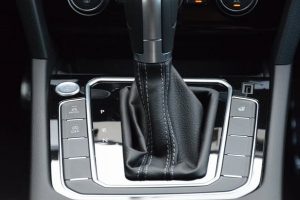
Not so much in luxury car.
Engineers work miracles. They have pumped things up – without (unlike steroids, say) apparent downsides. And they have dialed out the turbo lag and the previous peakiness that usually came with the a heavily turbo-boosted and tiny engine. Even the whistle is gone. There’s no indication from behind the wheel that there isn’t a V6 under the hood. More importantly – in the case of a car like this – that there isn’t a four under the hood.
VW didn’t even have to resort to the mechanical equivalent of the Little Blue Pill – “auditory enhancement,” via the sound system – to make up for the lack of good sounds being made by the little four.
Because it actually sounds good!
Something that is there – inside – is a traditional T-handle gear selector, which is becoming a hard-to-find thing in luxury cars and even just cars, generally.
The T handle is agreeable because it’s tactile. It’s more intuitive to move a handle forward and back and feel the positive engagement of the various detents for Park, Reverse and Drive than it is to turn a tactile-less knob or tap a toggle with no physical feedback at all that makes you look at an electronic readout to ascertain what gear you’re in.
It’s also not overteched, as many luxury-badged cars are (arguably, to try to justify their luxury-badged prices).
Most of the major functions – such as the climate controls – are still controlled with knobs and buttons.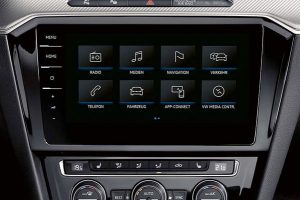
The Arteon drives like the large luxury car it is in everything but badge. Which means it’s a great way to get the luxury car – and the luxury car ride – without paying the price.
You also get visibility – something lacking in many new cars, regardless of price. The Arteon has frameless door glass – an elegant touch that’s getting hard to find outside of the luxury car class – and the door tops aren’t as high as your chin. In fact, they’re low enough that you can open the frameless door glass and rest your elbow on them, if you like.
One other thing about the Arteon’s that’s even more relaxing than being massaged is not being pestered by overly pre-emptive “assistance” technologies. The Arteon, like all new luxury cars, has these “assists” but their intrusions are less frequent and far less 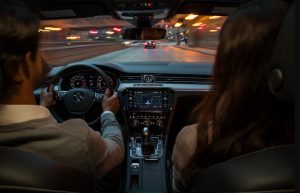 obstreperous.
obstreperous.
For example, you will feel the steering wheel move slightly, occasionally, when you stray a little out of your lane or don’t signal before you change lanes (Lane Keep Assist) but the wheel doesn’t jerk abruptly in the direction the car thinks you ought to be headed. Likewise, the Emergency Brake Assist doesn’t “assist” unless you’re actually pretty close to something you might hit – as opposed to other systems that slam on the brakes because a car 50 yards ahead just tapped its brakes.
The Artean is a pleasure to drive – and not just for the driver. It’s a pleasure to be taken for a ride in one, too.
At The Curb
VWs are attractive cars. The Arteon is a beautiful car.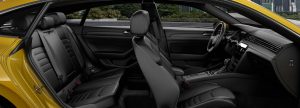
It looks like a supermodel who hasn’t been discovered yet, just wandering around the shopping mall.
Which means you can still date her.
It is also a strikingly practical car. Though almost exactly the same overall length as the Passat (191.4 inches vs. 191.9 inches) the Arteon’s interior space is both more generous and more evenly allocated.
The first and second rows have about the same legroom (41.2 inches and 40.2 inches) as well as nearly the same headroom (37.7 inches up front and 37 in back). It’s often the case that the second row not only has noticeably less legroom, but that headroom is noticeably less as well because of the angle of the roof – which (in a sedan with a trunk) tends to angle down more sharply and abruptly.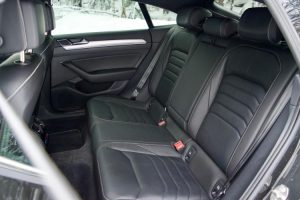
This is true in the Passat – and was true in the old Comfort Coupe, which actually wasn;t so comfortable… if you had to ride in back.
But not here.
If you lower the rear seatbacks, the Arteon has 55 cubic feet of cargo-carrying capacity – comparable to a crossover SUV of about the same overall size – vs. just 15.9 cubic feet in the trunk of the Passat (and just 13.2 cubic feet in the old CC).
Even with the back seats up, the Arteon has 27.2 cubic feet of cargo space – almost twice the Passat’s best-case capacity.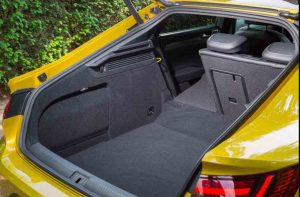
That’s the practical part.
There is also the luxury part, which includes standard three-zone climate control and an elegant glass (not plastic) faced secondary touchscreen that you don’t even have to touch. You can use gestures to control some of its functions.
Just wave your hand.
The Rest
The Arteon is one of the few cars you can buy for less than $50k that offers a massage feature. But it’s only offered to the driver. Usually, massaging seats (like heated seats) are offered in pairs.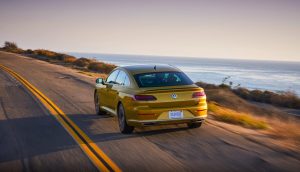
Your front seat passenger will probably want some driver’s seat time.
Some reviewers believe the Arteon – like the old Phaeton- is too pricey to be a VW. Well, to sell under the VW label. The counterargument to this is that the Arteon costs literally half what the Phaeton did – and about the same as a loaded Camry or Avalon does.
VW has also stepped up its warranty coverage across the board (all models) to six years and 72,000 miles – better coverage than almost all luxury-badged cars.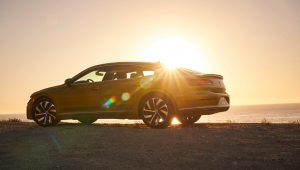
Another thing the Phaeton didn’t have.
The Bottom Line
It’s nowhere near as pricey as the Phaeton – but more luxurious. It’s even prettier than than the old Comfort Coupe – and the current Passat – and a lot more practical than either.
VW may finally have hit the spot.
. . .
Got a question about cars, Libertarian politics – or anything else? Click on the “ask Eric” link and send ’em in!
If you like what you’ve found here please consider supporting EPautos.
We depend on you to keep the wheels turning!
Our donate button is here.
If you prefer not to use PayPal, our mailing address is:
EPautos
721 Hummingbird Lane SE
Copper Hill, VA 24079
PS: Get an EPautos magnet (pictured below) in return for a $20 or more one-time donation or a $10 or more monthly recurring donation. (Please be sure to tell us you want a sticker – and also, provide an address, so we know where to mail the thing!)
My latest eBook is also available for your favorite price – free! Click here. 


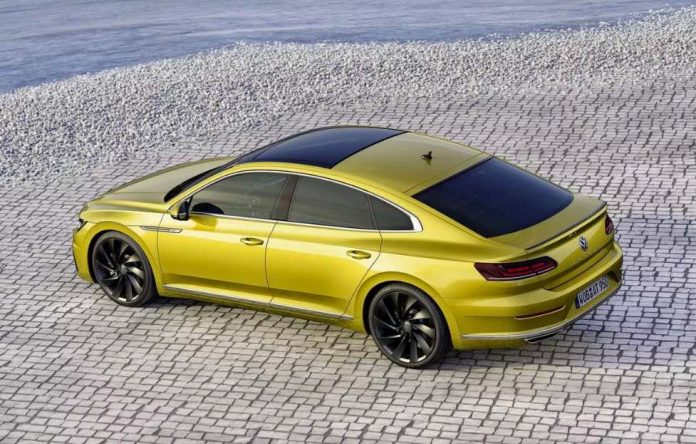

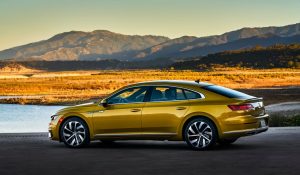

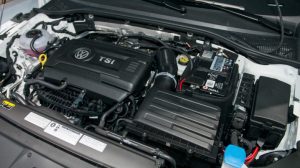
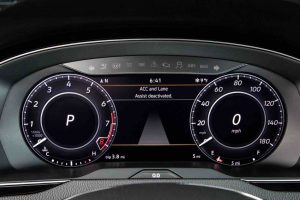







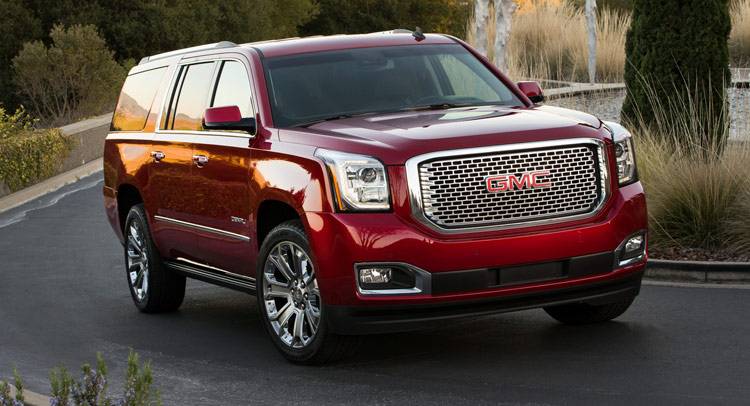
The car looks good and engine power is respectable. One downside maybe is that it needs premium gas (92,93 octane) and this will cost an additional 30 to 50 cents a gallon. But maybe the car is configured to run on regular but with less horsepower which would be nice?
Hi Euro,
All modern cars can adjust for octane, so you won’t risk any mechanical harm by using 87 regular in a modern car designed – optimized – for premium. What will happen is the ECU (engine computer) will dial back boost and spark timing to prevent mechanical harm. You may notice a dip in power/performance and mileage – but it’s not like the old days, when you risked potentially catastrophic detonation/pre-ignition by running lower octane gas in a high-compression/turbo or supercharged engine…
Why does a small car or even a large car need 13 speakers? My house, which it dozens of times larger than a car, only has 4 speakers, and much better sound.
Because most people like to go deaf and listen to loud music..Then the guys that want to hear the engine and loud music remove the mufflers and resonators so not only the music is deafening the drive is also!
Lots of people equate lots of speakers to the overall quality of the car,they brag my car has 8,10,13 speakers..Doesn’t impress me any..One of my cars has 2 in the dash and 1 in the rear(66 Chrysler 300)..
Look at these competition events and they have 5,000 speakers in cars..I laugh at those when I walk past at car shows…You’re home with 4 speakers does sound better more isn’t always better!!My 68 Charger has 2 6×9’s at the rear and 2 small dash speakers,also I added a small amp and the sound has a nice base and can go as loud as most can handle,better than most new cars too.Now I never was a music nut and I prefer to listen to the engine and other car sounds while driving,did it as a kid as my buddy worked at a shop so why not…I installed this back in the 1992 when I was 16 so..Also,don’t worry I put the modern radio mounted under the dash so I didn’t butcher anything even at 16 I wanted the car to look stock!
For myself I like to hear my engine but a nice note that you can still hear the person next to you and have the radio on at low volume..Example my 68 Charger RT has Dynomax mufflers a nice rumble and louder than stock as stock has quiet muffler,yes old muscle cars all has quiet mufflers..My new Challenger SRT is louder with stock mufflers than my old car with aftermarket turbo style mufflers and headers! Oh,my 68 looks stock but has a 440 thats built up and runs low 10’s in the 1/4 mile on street tires,full exhaust,interior car looks like it’s 1968 again..The 440 is now a 535 and runs on 89 if needed to..low compression! Also has 3.23 gears with a 3 speed automatic and I can go 90 mph on the highway and still hear myself and the whisperer beside me! So far 60,000 on the engine in a few years..
That’s the reason they don’t care if its electric or not..Now myself being a car guy I want to hear the engine(main reason I dislike electric)…Even a 4 or 6 I want to hear it..being a 8 cyl fan as they sound the best for myself anyways…
I went long,but was about sound/noise..sorry to bore you Happy New Year!
Hi Eric,
The percent of CO2 in the atmosphere is less than one-twenty-fifth of a percent. 0.04%. It is a trace gas.
Just thought I’d emphasize how scarce it actually is.
OT Im taking up a collection to buy this car please help https://www.streetsideclassics.com/vehicles/1004-phx/1980-ford-pinto-wagon-pro-street
Looks like they did a good job here. Myself, I think I’d probably end up with a Kia Stinger or Dodge Charger at this price and I’m a VW fan.
Agree, and both you mention are RWD based vs the VW fwd base. RWD is a game changer to me.
I would get the charger. I saw at least one stinger on a flatbead on an interstate being flatbedded to a repair facility. While the Stinger looks great, I question it’s long term reliability and design as well.
The Kia has the low sales #’s. I’ve always liked having something unique. At the same time, I’ve been eyeing a Charger for the past 5 years or so -kind of unique since I want sublime green.
Wonder if I could import/sneak in an Arteon with the 2.0 BiTDI SCR 4motion (240PS) engine that’s not allowed to be sold here? You get slightly less horsepower, but you get an additional 93 lb/ft of torque in the bargain (369 vs. 276.) Even better, it also puts out less CO2 emissions (152 g/km vs. the standard 164 g/km; bet the Envirotollahs won’t pay attention to that.) Also gets 33.13 city / 46.12 highway vs. the standard gas 22 city /31 highway (& has a 17.4 gallon fuel tank), but we’re not allowed to have nice things.
Sources:
https://en.wikipedia.org/wiki/Volkswagen_Arteon
https://www.auto-data.net/en/volkswagen-arteon-2.0-bitdi-240hp-4motion-dsg-28978
Too bad it costs over 50 grand when its all said and done. One could buy a nice home for that when I was a young man. Very nice car but us lemmings are being slowly priced out. Good review by the way.